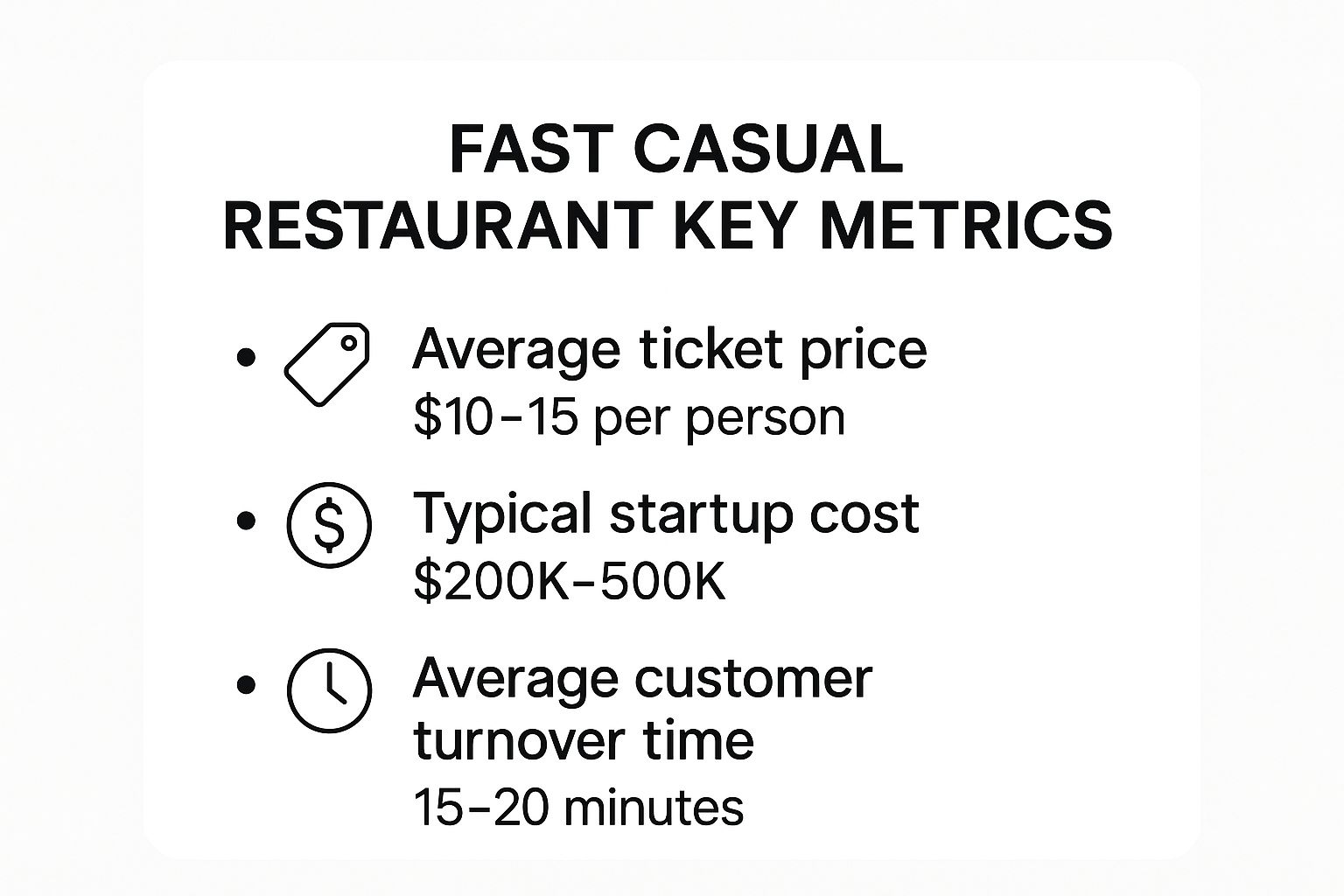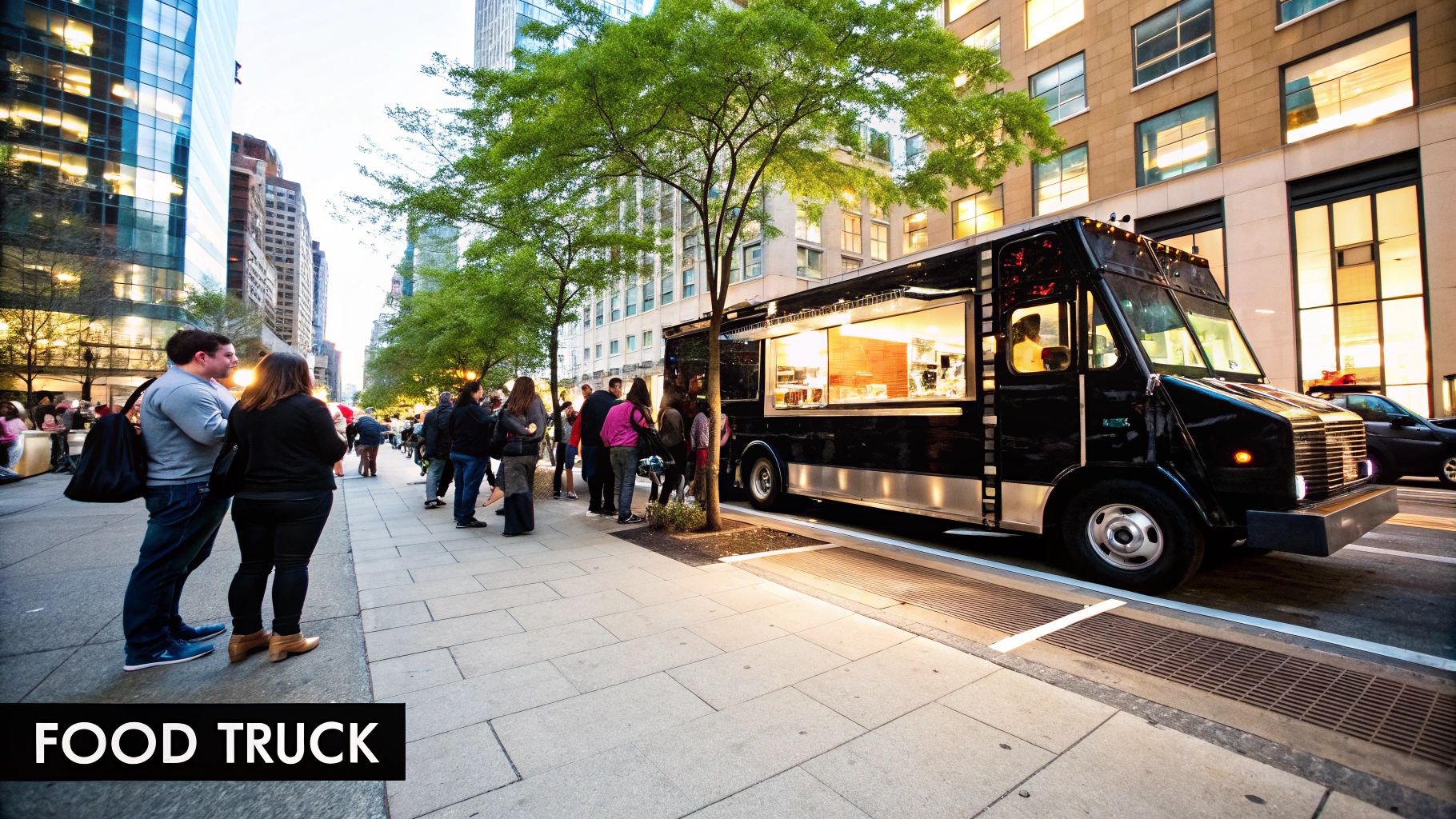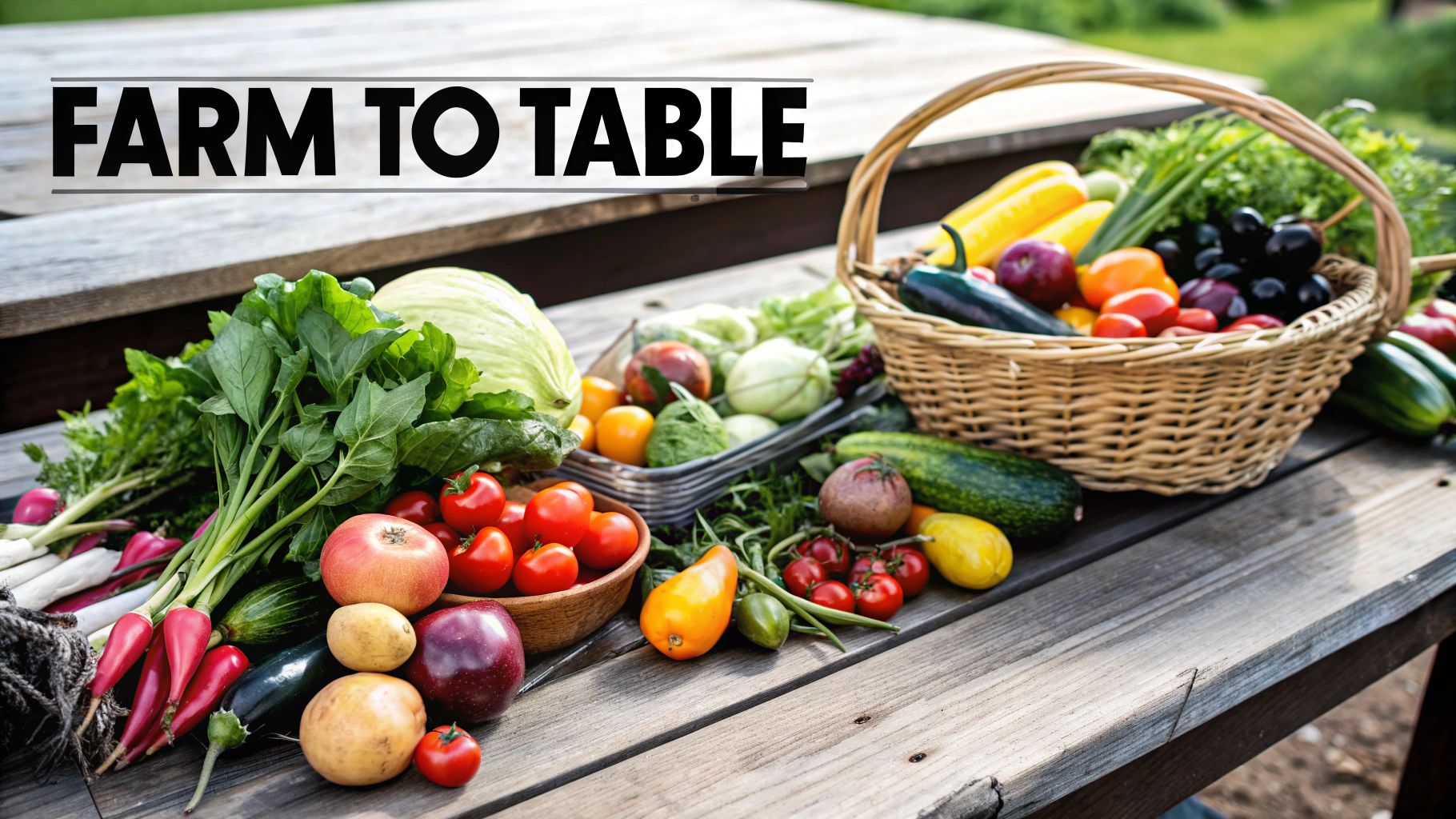Launching a successful restaurant requires more than just a great menu; it demands a solid strategy. A well-crafted business plan is the foundational blueprint for any aspiring small entrepreneur, guiding everything from funding to daily operations. For small business owners, understanding different business models and creating a robust marketing plan is critical to securing investment and navigating the competitive food industry.
A foundational step in any restaurant business plan is meticulous commercial kitchen layout planning, which directly impacts efficiency and profitability. But the overall strategy extends far beyond the kitchen. It must articulate your unique concept, define your target market, project your financials, and detail your marketing tactics. Without this comprehensive roadmap, even the most promising culinary ideas can falter.
This guide moves beyond generic templates to provide a deep analysis of seven distinct business plan examples for restaurants. We dissect each business model, from fast-casual to fine dining, offering actionable takeaways and replicable methods tailored for small business owners. We will explore the specific marketing and business plans behind each concept, helping you choose and develop the perfect strategy for your vision. Whether you're a solo entrepreneur dreaming of a ghost kitchen or a nimble food truck, these examples will equip you with the strategic insights needed to build a thriving enterprise from the ground up.
1. Fast Casual Restaurant Business Plan
The fast-casual model masterfully combines the speed of quick-service with the quality of casual dining, making it a powerful choice for a small entrepreneur. This business model centers on offering fresh, often customizable, higher-quality ingredients in a streamlined service environment. Customers typically order at a counter, watch their meal being prepared, and enjoy it in a modern, well-designed space. It’s an ideal model for entrepreneurs looking to capture the market segment that desires quality without the time commitment of a full-service restaurant.
Strategic Analysis: Why It Works for a Small Business
Successful fast-casual brands like Chipotle and Sweetgreen thrive by focusing on a few core principles. They build a strong brand identity around quality, freshness, and often, ethical sourcing. This isn't just a marketing tactic; it's a core operational pillar that influences every decision, from supplier selection to store design, which is a manageable focus for a small team.
Key Strategy: The core of a fast-casual business plan for a small entrepreneur is operational efficiency. By simplifying the menu (8-12 core items) and optimizing the production line, you can serve high volumes of customers quickly while maintaining exceptional quality and consistency.
Actionable Takeaways for Your Marketing and Business Plan
To build a compelling fast-casual business plan, focus on these critical areas:
- Technology Integration: Implement a robust online ordering system and a customer loyalty program from day one. This captures valuable data and builds repeat business, a crucial asset for a small business.
- Location Strategy: Target high-traffic areas near office parks, college campuses, and bustling retail centers. Your customer is often on a lunch break or looking for a quick, quality dinner option.
- Supplier Partnerships: As a small business, develop strong relationships with local suppliers to ensure a consistent stream of high-quality ingredients. This is non-negotiable for delivering on your brand promise.
- Staff Training: Your small team must be trained for speed, accuracy, and friendly customer interaction. They are the face of your efficient and high-quality brand.
The following infographic provides a quick reference for the key financial and operational metrics central to this business model.

These metrics highlight the model's focus on high volume and efficiency, showing how a moderate average ticket price can generate significant revenue through rapid customer turnover. This is a key financial projection to feature in your own business plan examples restaurant research.
2. Fine Dining Restaurant Business Plan
The fine dining model represents the pinnacle of the culinary world, offering an elevated experience built on exceptional food, impeccable service, and a sophisticated atmosphere. While capital-intensive, a small, focused fine dining establishment can be the passion project of a skilled entrepreneur-chef. This business model is less about a meal and more about creating a memorable event. It involves multi-course tasting menus, extensive wine lists, and highly choreographed service.
Strategic Analysis: Why It Works for a Niche Entrepreneur
Renowned establishments like The French Laundry and Eleven Madison Park succeed by creating an experience that transcends the plate. For a small entrepreneur, the key is to build a powerful brand identity around a visionary chef and an unwavering commitment to perfection. This brand equity allows them to command premium prices, attract top talent, and generate significant media attention, creating a self-sustaining cycle of prestige and profitability.
Key Strategy: The core of a fine dining business plan is the creation of an exclusive and unparalleled guest experience. This is achieved by meticulously controlling every detail, from ingredient sourcing and menu design to staff training and dining room ambiance, justifying a high price point and fostering a loyal clientele.
Actionable Takeaways for Your Marketing and Business Plan
To develop a robust fine dining restaurant business plan, a small entrepreneur must concentrate on these foundational elements:
- Culinary Leadership: The business plan must center on an executive chef (often the owner) who has a proven track record and a distinct culinary vision. Their reputation will be a cornerstone of your marketing plan and brand identity.
- Financial Planning: Create a detailed financial model that accounts for high food and labor costs. Secure enough operating capital to sustain the business for 18-24 months before reaching profitability.
- Supplier Excellence: Forge direct relationships with premium purveyors, farmers, and vintners. The story behind your ingredients is a crucial part of the fine dining narrative and justifies premium pricing.
- Service Protocol: Invest heavily in comprehensive and continuous staff training. A small, well-trained team must be knowledgeable, poised, and intuitive, executing their roles flawlessly.
By focusing on these areas, your business plan examples restaurant research will transform into a concrete strategy for launching a successful high-end establishment. Learn more about crafting a Fine Dining Restaurant Business Plan to ensure every detail is covered.
3. Food Truck Business Plan
The food truck business model offers a dynamic and flexible alternative to traditional brick-and-mortar restaurants, allowing entrepreneurs to take their culinary concepts directly to the customer. This model thrives on mobility, lower startup costs, and the ability to test different markets and menu items with minimal risk. Operating from a custom-equipped vehicle, food trucks can capitalize on high-traffic locations and events, making them a popular choice for first-time small business owners.

Strategic Analysis: Why It Works for Entrepreneurs
Successful food trucks, like the pioneering Kogi BBQ, understand that their business is about more than just food; it’s about creating an event and a following. They leverage social media to build a community, announcing locations in real-time and creating a sense of urgency. This direct line of communication turns customers into loyal fans who will actively seek out the truck, a perfect grassroots marketing plan for a small business.
Key Strategy: The core of a food truck business plan is hyper-specialization and location intelligence. By mastering a small, unique menu that can be executed quickly, a small entrepreneur creates a signature brand. Success then depends on tracking sales data to identify and rotate between the most profitable locations.
Actionable Takeaways for Your Marketing and Business Plan
To develop a robust food truck business plan, concentrate on these essential components:
- Master Local Regulations: Thoroughly research and secure all necessary permits, licenses, and health certifications for every area you plan to operate in. This is a critical first step for any small business.
- Build a Strong Digital Presence: Your social media accounts are your primary marketing tool. This low-cost, high-impact marketing plan is perfect for entrepreneurs. Post your schedule, showcase your food, and engage with followers.
- Optimize Your Menu for Speed: Focus on 5-7 signature items that are delicious, unique, and can be prepared quickly. Efficiency is key to managing long lines and maximizing revenue during peak hours.
- Secure Diverse Revenue Streams: Don't rely solely on street-side sales. Actively pursue relationships with event organizers and local businesses for lunch services to create a stable income. For those specifically interested in mobile dining, you can find guidance on developing a winning food truck business plan.
The video below offers insights into the operational realities and opportunities of running a food truck.
By combining a unique concept with strategic mobility and a savvy marketing plan, a food truck can be a highly profitable venture for a small entrepreneur. You can explore a complete Food Truck Business Plan to get started.
4. Franchise Restaurant Business Plan
Opting for a franchise model is like buying a "business in a box." It offers entrepreneurs a turnkey solution with an established brand, proven operational systems, and a built-in marketing plan. This business model is ideal for a small business owner who wants to mitigate the high risks of a startup by leveraging a successful, pre-existing framework. You pay an initial fee and ongoing royalties in exchange for the franchisor's brand name, menu, supply chain, and comprehensive training.
Strategic Analysis: Why It Works for a First-Time Owner
Franchises like Subway and Dunkin' succeed by replicating a proven formula with incredible consistency. The brand recognition is already established, which significantly reduces the marketing burden on the individual franchisee. The franchisor has already figured out the menu, operational workflows, and supplier relationships, allowing the small business owner to focus on execution and local management.
Key Strategy: The core of a franchise business plan is not invention but strict adherence to a proven system. Your plan must demonstrate a deep understanding of the franchisor's business model and your capability to execute it flawlessly within your designated territory.
Actionable Takeaways for Your Marketing and Business Plan
To develop a compelling franchise restaurant business plan, concentrate on these essential areas:
- Due Diligence: Thoroughly review the Franchise Disclosure Document (FDD). This legal document contains critical information about the franchisor's financial health, litigation history, and the full scope of fees.
- Capital Planning: Your financial projections must be comprehensive, accounting for the initial franchise fee, real estate, and substantial working capital. Lenders want to see small entrepreneurs are well-capitalized.
- Local Market Analysis: Your business plan needs to show a deep analysis of your specific territory. The marketing plan should detail how you'll adapt the national brand's message to attract local customers and outperform competitors.
- Operational Excellence: The plan must outline your commitment to the franchisor’s standards. Detail your management structure and staff training programs, emphasizing how you will uphold the brand’s reputation.
By focusing on these elements, your business plan examples restaurant research will lead to a document that proves you are a capable operator ready to represent the brand.
5. Ghost Kitchen/Virtual Restaurant Business Plan
The ghost kitchen business model is a revolutionary approach perfect for lean small entrepreneurs. It strips the traditional restaurant down to its core: a kitchen built for delivery and takeout. By eliminating the dining room and front-of-house staff, this model drastically reduces overhead. Operators leverage third-party delivery apps and direct online ordering to reach customers, often running multiple unique brands from a single kitchen. This lean, tech-forward model is perfect for entrepreneurs aiming to test concepts with minimal risk.
Strategic Analysis: Why It Works for a Small Entrepreneur
The success of virtual brands stems from their ability to meet modern consumer demand for convenience head-on. They operate with unparalleled agility, capable of launching and testing new menu concepts based on real-time data. This data-driven approach allows for precise targeting, a major advantage for a small business with a limited marketing budget.
Key Strategy: The central pillar of a ghost kitchen business plan is a deep focus on the digital marketing plan. Since there's no physical storefront, your entire brand identity and customer acquisition exist online. Exceptional food photography, aggressive social media marketing, and stellar online reviews are the business itself.
Actionable Takeaways for Your Marketing and Business Plan
To craft a successful virtual restaurant business plan, a small business owner must prioritize these digital-first elements:
- Menu Engineering for Delivery: Design a concise menu where every item is tested for its ability to travel well. Items should maintain temperature, texture, and presentation after a 20-30 minute journey.
- Packaging Investment: High-quality, branded packaging is a critical touchpoint and a key part of your marketing plan. It protects food integrity and communicates your brand's quality.
- Data Analysis: Use analytics from delivery platforms to understand peak order times and popular items. Use this data to refine menus, run promotions, and optimize pricing.
- Direct Ordering Channel: While third-party apps are essential, build your own website or app for direct orders. This allows you to capture customer data and avoid high commission fees, boosting profitability for a small business.
Creating a compelling business plan examples restaurant document for this model means demonstrating a clear understanding of the digital marketplace and operational logistics.
6. Farm-to-Table/Sustainable Restaurant Business Plan
The farm-to-table business model is built on a direct connection between a restaurant and its local food sources. This approach is ideal for a small entrepreneur with a passion for community and sustainability. It prioritizes sourcing ingredients from local farms, resulting in menus that are hyper-seasonal, fresh, and deeply rooted in the local area. It appeals to consumers who value transparency and are willing to pay a premium for high-quality, ethically sourced food.

Strategic Analysis: Why It Works for a Small Business
Pioneers like Alice Waters of Chez Panisse proved that a compelling story and superior ingredients create an unforgettable dining experience. The success of this model hinges on authenticity. The brand narrative is a direct reflection of the supply chain. A small business can excel here by building genuine relationships with local farmers, creating a story that larger chains can't replicate.
Key Strategy: The core of a farm-to-table business plan is building a resilient and flexible local supply chain. You must build relationships with producers first and design your menu around what they can consistently provide. This is a unique operational challenge and a key selling point.
Actionable Takeaways for Your Marketing and Business Plan
To craft a successful farm-to-table business plan, a small entrepreneur should concentrate on these elements:
- Supplier Relationship Mapping: Dedicate a section of your business plan to your key local producers. Detail your primary and backup suppliers for each food category.
- Menu Engineering for Flexibility: Design a "menu template" rather than a fixed list. Create core concepts that can easily adapt to ingredient substitutions based on what's available from the farm that week.
- Storytelling and Marketing: Your marketing plan must focus on educating the customer. Use your menu, website, and social media to share the stories of your farm partners. This authentic content is a powerful tool for a small business.
- Waste Reduction Program: Implement a comprehensive system for minimizing food waste. This includes whole-animal butchery and creative use of scraps, which supports both sustainability and profitability.
These actionable steps are crucial when developing business plan examples restaurant that truly embrace the farm-to-table philosophy.
7. Ethnic/Cultural Specialty Restaurant Business Plan
An ethnic or cultural specialty restaurant builds its entire identity around authentic cuisine from a specific region. This business model is perfect for a small entrepreneur looking to share their heritage or passion. It moves beyond generic representations to offer a deep dive into genuine flavors, often using family recipes and traditional cooking methods. Success hinges on preserving cultural integrity while making the cuisine accessible to a broader audience.
Strategic Analysis: Why It Works for an Entrepreneur
Successful cultural restaurants excel by becoming ambassadors for their cuisine. They don't just sell food; they share stories and create an immersive cultural environment. This focus allows a small business to build a passionate community following. The staff is trained to guide newcomers through unfamiliar dishes, turning a simple meal into a memorable exploration.
Key Strategy: The core of this business plan is authenticity as a brand differentiator. The marketing plan should focus on credibility by sourcing authentic ingredients, mastering traditional techniques, and telling the cultural story behind your food. This creates a powerful connection that mainstream competitors cannot replicate.
Actionable Takeaways for Your Marketing and Business Plan
To develop a robust cultural specialty restaurant business plan, a small entrepreneur must prioritize these elements:
- Supply Chain Management: Identify and secure reliable suppliers for hard-to-find ingredients early on. This is critical for maintaining authenticity. This process is similar to what's needed for a specialty food store.
- Menu Engineering & Education: Design a menu that includes both authentic dishes and more approachable "gateway" options. Your marketing plan should include educating customers through detailed descriptions and well-trained staff.
- Community Engagement: Actively build relationships within the local ethnic community to gain credibility and a loyal customer base. Partnering with cultural organizations is a great low-cost marketing tactic for a small business.
- Immersive Atmosphere: Invest in décor, music, and service styles that reflect the culture. A cohesive and authentic atmosphere enhances the dining experience.
By focusing on these areas in your business plan examples restaurant research, you can build a venture that is not only profitable but also culturally significant.
7 Restaurant Business Plan Types Comparison
| Business Plan Type | Implementation Complexity 🔄 | Resource Requirements 💡 | Expected Outcomes 📊 | Ideal Use Cases 💡 | Key Advantages ⭐ |
|---|---|---|---|---|---|
| Fast Casual Restaurant | Medium complexity; requires efficient ops & tech | Moderate startup cost ($250k-$500k), trained staff | Moderate to high revenue; fast turnover; scalable | Entrepreneurs seeking quality & speed for a broad market | Lower labor costs; higher profit margins; scalable |
| Fine Dining Restaurant | High complexity; needs expert chefs & formal service | High startup cost ($750k-$2M+), skilled workforce | High check averages; strong brand loyalty; prestige | Chef-entrepreneurs, special occasions, destination dining | Premium pricing; media attention; brand prestige |
| Food Truck | Low to medium complexity; mobile operations | Low startup cost ($75k-$150k), small staff | Flexible revenue; potential rapid growth | First-time entrepreneurs, event catering, testing concepts | Low cost; mobility; strong social media marketing |
| Franchise Restaurant | Medium complexity; follows established systems | Varies widely ($150k-$2M); franchisor support | Steady revenue; lower failure risk | Entrepreneurs seeking proven models & brand recognition | Proven systems; training & marketing support |
| Ghost Kitchen / Virtual Restaurant | Medium complexity; delivery optimization focused | Low startup cost ($50k-$150k), minimal front staff | Lower overhead; quick market testing | Lean startups, tech-savvy entrepreneurs, multiple brand operators | Low costs; multiple concepts; data-driven ops |
| Farm-to-Table / Sustainable | High complexity; supply chain intensive | Moderate-high cost ($300k-$750k), extensive supplier network | Premium pricing; loyal niche market | Community-focused entrepreneurs, sustainability advocates | Strong differentiation; sustainability; premium pricing |
| Ethnic/Cultural Specialty | Medium complexity; import & authenticity challenges | Moderate cost ($200k-$500k), specialized knowledge | Niche market loyalty; cultural authenticity impact | Entrepreneurs sharing their heritage, adventurous foodies | Unique differentiation; community support |
From Plan to Plate: Activating Your Restaurant's Future
Throughout this guide, we have explored a diverse menu of business plan examples restaurant owners can use, from the agile food truck to the elegant fine dining establishment. Each business model, whether it's a ghost kitchen leveraging digital platforms or a farm-to-table concept built on local supply chains, offers a unique blueprint for success for the small entrepreneur. The common thread weaving through all of them is the undeniable power of a meticulously crafted, dynamic business plan.
Your business plan is far more than a document for investors; it is the strategic heart of your small business. It forces you to move beyond the passion for food and confront the critical realities of your market, your finances, and your operational capacity. The examples demonstrate that the most successful ventures are those where the concept, target audience, and financial projections are in perfect alignment.
Key Takeaways for Your Entrepreneurial Journey
As a small business owner moving from inspiration to execution, keep these core principles at the forefront of your planning:
- Adaptability is Your Secret Ingredient: The restaurant industry is in constant flux. A business plan is not a static one-time task but a living document. Revisit your financial projections, marketing plans, and operational workflows quarterly to adapt to market shifts and consumer trends.
- Know Your Numbers, Own Your Future: A deep understanding of your financial section, from startup costs to break-even analysis, is non-negotiable. This financial clarity empowers you to make informed decisions and steer your small business toward sustainable profitability.
- Marketing is Not an Afterthought: As seen in the food truck and ghost kitchen examples, a robust marketing plan is essential from day one. Your business plan must detail exactly how you will attract and retain customers, whether through social media engagement, local partnerships, or a loyalty program.
Your Actionable Next Steps
Feeling inspired? It's time to channel that energy into action. Begin by selecting the business model that most resonates with your vision and resources. Use the corresponding example as a structural guide, but commit to conducting your own original research. Dive deep into your local market analysis, identify your ideal customer profile, and start building a realistic marketing plan and financial projections.
Remember, the goal of studying these business plan examples for a restaurant is not to copy them verbatim, but to internalize the strategic thinking behind them. This process will equip you to build a resilient, thriving restaurant that not only survives but flourishes. Your detailed business plan is your most valuable tool for turning a culinary dream into a successful small business reality.
Ready to build a professional-grade business plan without the guesswork? GrowthGrid leverages AI to help entrepreneurs like you generate comprehensive business and marketing plans, complete with market analysis and financial projections, in minutes. Stop staring at a blank page and start building your future today by visiting GrowthGrid.
